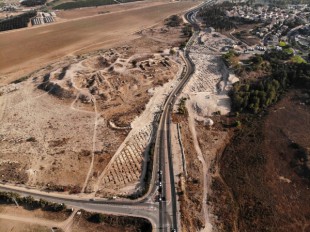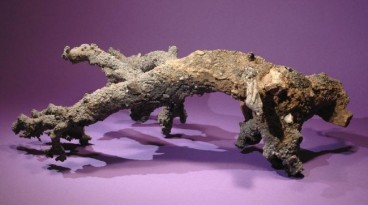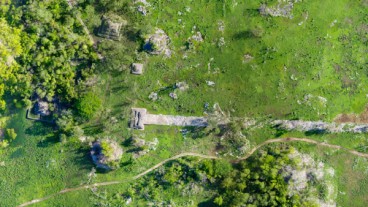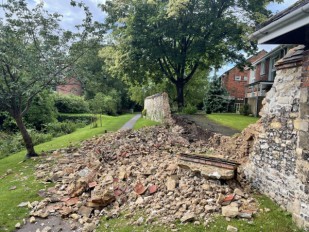Neolithic rock monument possibly built to attract lightning bolts

A new-found monument located in Scotland may have been deliberately built to attract lightnings, according to scientists.
Researchers are investigating a recently discovered stone circle that is located close to the well-known Calanais Standing Stones monument which was constructed between 2900 and 2600 BC in the Isle of Lewis, Scotland.
The new monument consists of a series of stones placed to create a circular pattern where traces of at least one lightning strike exist. Scientists believe that the monument was deliberately built to attract a bolt of lightning.
The erection of such rock monuments was mainly provoked by Neolithic people's interest in the changes of the Sun's positions and the seasons. The new evidence reveals that natural phenomena such as lightning bolts may have also been significantly admired by people during that period.
The ancient rock circle was discovered during a project conducted by Dr. Richard Bates, an archaeologist and Senior Lecturer in Earth Sciences at the University of St. Andrews, Scotland, and his research team. The purpose of the project was to detect hidden monuments near the Calanais Stones. Due to the fact that the area is currently coved by marshes, scientists utilized non-invasive remote sensing techniques, including electrical resistivity tomography and electromagnetic surface mapping, to assess the substratum.
The research team found out that the circle was hit by lightnings as a magnetic abnormality was detected in its center. Scientists cannot determine whether this anomaly was caused by one or multiple lightnings. Moreover, the exact time of the events (before or after the construction of the monument) could not also be derived. Nevertheless, Dr. Bates believes that the fact that the lightning struck at the center of the circle cannot be incidental. “Whether the lightning at Site XI (the new-found monument) focused on a tree or rock which is no longer there, or the monument itself attracted strikes, is uncertain. However, this remarkable evidence suggests that the forces of nature could have been intimately linked with everyday life and beliefs of the early farming communities on the island,” Dr. Bates, stated.
The authors emphasize the worship and respect of Neolithic people for nature and suggest that further research should be conducted to reveal more monuments that may be hidden below the ground. “The archaeological literature increasingly recognizes the symbiotic role between culture and nature in the past and, if that were the case at Site XI, this survey demonstrates the benefit of exploring buried landscapes of the western Hebrides through careful use of different remote sensing techniques," the scientific team stated.
Source: Gizmodo
Source: Gizmodo
Want to read more like this story?

Archaeological sites in Israel threatened due to construction boom
Jun, 24, 2020 | NewsAccording to some researchers, archaeological sites in Israel are vulnerable due to the rapid growth...

Fulgurite: A rare phenomenon
Nov, 11, 2015 | NewsA bolt of lightning is able to deliver up to 5 gigajoule of energy (energy that can power a house in...

Lightning strike causes explosion in Oxfordshire recycling plant
Oct, 02, 2023 | NewsA lightning strike caused an explosion at a food waste recycling plant, which lit up Oxfordshire’s...
The Notre Dame cathedral fire revealed a long-hidden secret for the famous Parisian monument
Mar, 22, 2023 | NewsNotre-Dame was the first Gothic cathedral whose construction made extensive use of iron staples. Th...

LiDAR study reveals information about great Maya road
Feb, 19, 2020 | NewsScientists utilized LiDAR data to study the longest road constructed during the Maya era. LiDAR (...

New technique to monitor structural deformation in real time
Mar, 16, 2020 | NewsScientists have developed a new, low-cost method to detect and precisely measure the deformation of...

Housing shortage addressed by building over railways in London
Dec, 14, 2018 | NewsNew research shows that the housing shortage in London could be eliminated by constructing buildings...

Huge Floods Sculpt Colorado’s Mountain Landscape
Apr, 03, 2015 | NewsHeavy rains in 2013 lead to devastating floods of rock, soil, and water through many cities and town...

Section of iconic wall in Winchester, UK, collapses
Jul, 28, 2021 | NewsA section of a historic wall located in Winchester, UK collapsed on July 6, 2021. Winchester is a...
Trending

Vertical gardens in Mexico City to combat pollution

Characteristics of Load Bearing Masonry Construction

Taipei 101’s impressive tuned mass damper

Saudi Park Closed After 360 Big Pendulum Ride Crashes to Ground, 23 injured

Dutch greenhouses have revolutionized modern farming

Federal court rules Biden’s offshore drilling ban unlawful


